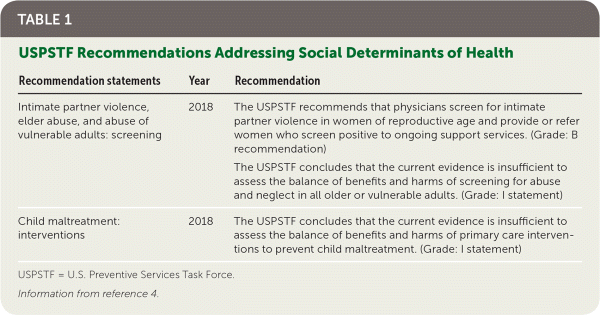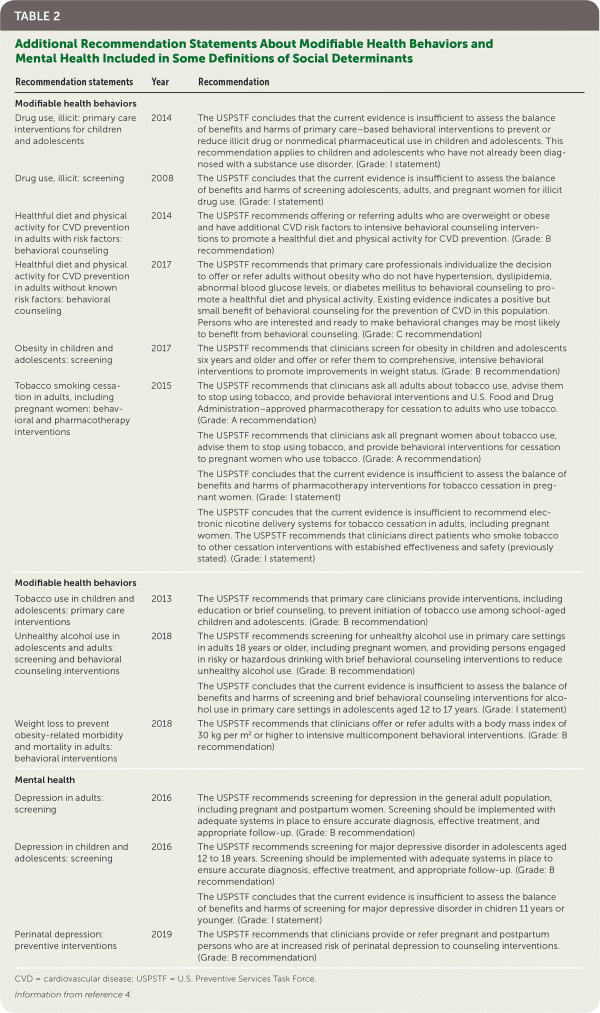
Am Fam Physician. 2019;99(10):602-605
Related U.S. Preventive Services Task Force: Screening for Intimate Partner Violence, Elder Abuse, and Abuse of Vulnerable Adults: Recommendation Statement
Related Putting Prevention into Practice: Screening for Intimate Partner Violence, Elder Abuse, and Abuse of Vulnerable Adults
Author disclosure: Drs. Krist and Davidson are members of the U.S. Preventive Services Task Force. Dr. Ngo-Metzger is a member of the Agency for Healthcare Research and Quality.
Social and economic factors have a greater influence on health than clinical care.1 Sadly, having a social need is common. In 2017, 12.3% of Americans experienced poverty, half a million people were homeless, 10% of households had food insecurity, and 8% had no health insurance.2 Social needs contribute to health inequities and higher health care costs. Despite this, the U.S. Preventive Services Task Force (USPSTF) has reviewed the evidence for screening for only two social determinants of health (based on the Healthy People 2020 definition of social determinants).3 The USPSTF gives a B recommendation for screening women of childbearing age for intimate partner violence (IPV) and an I statement for screening for child maltreatment (Table 1).4 The USPSTF has recommendations for nine health behaviors and three mental health recommendations that are included in some definitions of social determinants of health (Table 2).4

| Recommendation statements | Year | Recommendation |
|---|---|---|
| Intimate partner violence, elder abuse, and abuse of vulnerable adults: screening | 2018 | The USPSTF recommends that physicians screen for intimate partner violence in women of reproductive age and provide or refer women who screen positive to ongoing support services. (Grade: B recommendation) The USPSTF concludes that the current evidence is insufficient to assess the balance of benefits and harms of screening for abuse and neglect in all older or vulnerable adults. (Grade: I statement) |
| Child maltreatment: interventions | 2018 | The USPSTF concludes that the current evidence is insufficient to assess the balance of benefits and harms of primary care interventions to prevent child maltreatment. (Grade: I statement) |

| Recommendation statements | Year | Recommendation |
|---|---|---|
| Modifiable health behaviors | ||
| Drug use, illicit: primary care interventions for children and adolescents | 2014 | The USPSTF concludes that the current evidence is insufficient to assess the balance of benefits and harms of primary care–based behavioral interventions to prevent or reduce illicit drug or nonmedical pharmaceutical use in children and adolescents. This recommendation applies to children and adolescents who have not already been diagnosed with a substance use disorder. (Grade: I statement) |
| Drug use, illicit: screening | 2008 | The USPSTF concludes that the current evidence is insufficient to assess the balance of benefits and harms of screening adolescents, adults, and pregnant women for illicit drug use. (Grade: I statement) |
| Healthful diet and physical activity for CVD prevention in adults with risk factors: behavioral counseling | 2014 | The USPSTF recommends offering or referring adults who are overweight or obese and have additional CVD risk factors to intensive behavioral counseling interventions to promote a healthful diet and physical activity for CVD prevention. (Grade: B recommendation) |
| Healthful diet and physical activity for CVD prevention in adults without known risk factors: behavioral counseling | 2017 | The USPSTF recommends that primary care professionals individualize the decision to offer or refer adults without obesity who do not have hypertension, dyslipidemia, abnormal blood glucose levels, or diabetes mellitus to behavioral counseling to promote a healthful diet and physical activity. Existing evidence indicates a positive but small benefit of behavioral counseling for the prevention of CVD in this population. Persons who are interested and ready to make behavioral changes may be most likely to benefit from behavioral counseling. (Grade: C recommendation) |
| Obesity in children and adolescents: screening | 2017 | The USPSTF recommends that clinicians screen for obesity in children and adolescents six years and older and offer or refer them to comprehensive, intensive behavioral interventions to promote improvements in weight status. (Grade: B recommendation) |
| Tobacco smoking cessation in adults, including pregnant women: behavioral and pharmacotherapy interventions | 2015 | The USPSTF recommends that clinicians ask all adults about tobacco use, advise them to stop using tobacco, and provide behavioral interventions and U.S. Food and Drug Administration–approved pharmacotherapy for cessation to adults who use tobacco. (Grade: A recommendation) The USPSTF recommends that clinicians ask all pregnant women about tobacco use, advise them to stop using tobacco, and provide behavioral interventions for cessation to pregnant women who use tobacco. (Grade: A recommendation) The USPSTF concludes that the current evidence is insufficient to assess the balance of benefits and harms of pharmacotherapy interventions for tobacco cessation in pregnant women. (Grade: I statement) The USPSTF concudes that the current evidence is insufficient to recommend electronic nicotine delivery systems for tobacco cessation in adults, including pregnant women. The USPSTF recommends that clinicians direct patients who smoke tobacco to other cessation interventions with estabished effectiveness and safety (previously stated). (Grade: I statement) |
| Tobacco use in children and adolescents: primary care interventions | 2013 | The USPSTF recommends that primary care clinicians provide interventions, including education or brief counseling, to prevent initiation of tobacco use among school-aged children and adolescents. (Grade: B recommendation) |
| Unhealthy alcohol use in adolescents and adults: screening and behavioral counseling interventions | 2018 | The USPSTF recommends screening for unhealthy alcohol use in primary care settings in adults 18 years or older, including pregnant women, and providing persons engaged in risky or hazardous drinking with brief behavioral counseling interventions to reduce unhealthy alcohol use. (Grade: B recommendation) The USPSTF concludes that the current evidence is insufficient to assess the balance of benefits and harms of screening and brief behavioral counseling interventions for alcohol use in primary care settings in adolescents aged 12 to 17 years. (Grade: I statement) |
| Weight loss to prevent obesity-related morbidity and mortality in adults: behavioral interventions | 2018 | The USPSTF recommends that clinicians offer or refer adults with a body mass index of 30 kg per m2 or higher to intensive multicomponent behavioral interventions. (Grade: B recommendation) |
| Mental health | ||
| Depression in adults: screening | 2016 | The USPSTF recommends screening for depression in the general adult population, including pregnant and postpartum women. Screening should be implemented with adequate systems in place to ensure accurate diagnosis, effective treatment, and appropriate follow-up. (Grade: B recommendation) |
| Depression in children and adolescents: screening | 2016 | The USPSTF recommends screening for major depressive disorder in adolescents aged 12 to 18 years. Screening should be implemented with adequate systems in place to ensure accurate diagnosis, effective treatment, and appropriate follow-up. (Grade: B recommendation) The USPSTF concludes that the current evidence is insufficient to assess the balance of benefits and harms of screening for major depressive disorder in chidren 11 years or younger. (Grade: I statement) |
| Perinatal depression: preventive interventions | 2019 | The USPSTF recommends that clinicians provide or refer pregnant and postpartum persons who are at increased risk of perinatal depression to counseling interventions. (Grade: B recommendation) |
Given the well-described health effects of social needs in primary care, why has the USPSTF not evaluated whether to screen for other social determinants? Several reasons are possible: topics have not been previously nominated, screening for some social determinants was previously considered outside the scope of primary care, and assessing benefits and harms of screening in primary care is supported by limited evidence. Times are changing, however. Greater interest is being shown in addressing social needs in primary care.5–8 Screening tools and interventions are being developed and tested, and evidence is evolving. Reflecting on these changes, the USPSTF is currently conducting an evaluation to understand the state of screening for social determinants of health.
Physicians are faced with deciding whether they should screen their patients for social needs. The absence of evidence of benefit is not evidence that benefit is absent. Conversely, physician and patient time is limited, and the two should focus on efforts that clearly have been shown to improve patient health and well-being. The USPSTF recommendations for IPV and child maltreatment screening serve as good examples to highlight considerations when deciding whether to screen for other social needs. For IPV screening, the USPSTF found several questionnaires with good sensitivity and specificity. After IPV has been identified, interventions such as counseling, home visits, mentoring, and referral to community services resulted in reduced IPV events for women of reproductive age. Finally, no screening or treatment harms were identified.9 Conversely, the USPSTF found no specific validated instruments to identify children at risk of maltreatment among those who do not exhibit any specific signs or symptoms, although many known risk factors exist (e.g., younger maternal age, nonbiologic parents, families with history of maltreatment or substance misuse). The USPSTF identified 22 studies evaluating interventions for at-risk children, including home visits, family education and support, and even removal of children from their home. Studies showed mixed results in terms of outcomes, such as reduced child protective services involvement, emergency department visits, or hospitalizations; pooled analysis of all studies showed no benefit.10 The USPSTF concluded that this evidence was inadequate to identify ways in which to best identify children at risk of maltreatment and to prevent future maltreatment.
These recommendations highlight what is needed before recommending routine screening for social needs: an accurate screening test to identify patients with the social need, an effective treatment to address the social need once identified, and evidence demonstrating a meaningful health outcome improvement for patients. We know that having a social need leads to poorer health. In some cases, we even know that screening identifies those with a need, but often we do not know what to do after we have identified the need.
It is likely premature to recommend routine screening for all social needs. More evidence is needed, and further evaluation regarding the state of the existing evidence is necessary. Screening for social needs entails proactively asking about or assessing a condition when a patient is not known to have that condition, systematically using a validated screening tool, and delivering an effective intervention whenever needs are identified. Given the effects of social determinants of health, a more reasonable approach may be for physicians to practice case finding. This entails asking about or assessing social needs when a concern is apparent but not asking every patient about every social determinant of health. Social needs may surface when obtaining a patient history. Specific signs or symptoms may hint that a patient has a social need. Physicians' knowledge of the community they serve may suggest that certain groups of patients are at greater risk of certain issues. Understanding a patient's social needs can be part of getting to know your patient. When social needs are identified, tools such as the American Academy of Family Physicians Neighborhood Navigator 11,12 can help identify local resources to help patients; practices may want to establish collaborative partnerships with community organizations to care for recurring social needs in their patient population.13
Social determinants have a large effect on patients' health and well-being. Primary care clinicians need more evidence about their role in addressing social determinants of health, and community resources and public health support are needed to help patients with unmet social needs.
